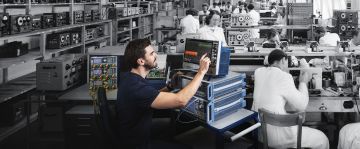Jena, in the late 1920s. The fellow physics students Lothar Rohde and Hermann Schwarz discovered their fascination for high frequency engineering, which was uncharted territory at the time. They set to work and in 1932 created an interference wavemeter under contract to Hermsdorf-Schomburg-Isolatoren-Gesellschaft (Hescho). The instrument was a huge success and encouraged the two young men to establish the Physikalisch-Technisches Entwicklungslabor (PTE). The company’s first registered office was a rented apartment on Thierschstraße in Munich
"Driven by our passion for technology, we create the innovations the market needs – to the highest quality standards. Our customers and partners can rely on that. Our mission is clear: to make ideas real – yesterday, today and tomorrow."
Christian Leicher, President and CEO of Rohde & Schwarz
Technological developments make history
Over the following years, PTE developed many other instruments that were milestones not only for the company itself but also the history of technology. For example, the company brought the first portable crystal clock to the market in 1938. Two years later, it released the WIP all-wave frequency meter. Due to the increasing number of orders, the young pioneers started to look for ways to increase production capacity. They found exactly what they were looking for in the Allgäu region of Bavaria and established Messgerätebau GmbH in 1941. The first production site outside of Munich initially began life in Kempten in 1943 before moving to Memmingen a year later.
In early 1949, the young company started developing and producing VHF transmitters – its second source of income alongside the burgeoning test and measurement business. The mid-1950s finally saw the company move into radiocommunications, radiomonitoring and radiolocation. For the latter, Rohde & Schwarz produced the NAP1 automatic visual direction finder, an important device for air traffic control.
Quality and independence through outstanding vertical integration
The company’s growth and progress were soon reflected in growing employee numbers and sales figures. By 1960, the company already had 2000 employees. After struggling with capacity and space for several years, the founders decided to build a new site on the corner of Trausnitzstraße and Mühldorfstraße close to Munich East Station in 1956. The company’s headquarters are still located there today. Production capacity was also expanded in Memmingen. In 1969, an additional plant was established in Teisnach in Lower Bavaria. With two plants in Germany and a further production site in Munich, the company had now laid the foundations for its high degree of vertical integration, which not only helped ensure the highest quality standards but also that the company remained independent and flexible. That decision proved to have incredible economic foresight to this day, in times of economic uncertainty and fragile supply chains.
In the early 1970s, the company leaders made an important strategic decision by adding Friedrich Schwarz – the next generation of the Schwarz family – to the Executive Board. The son of Dr. Hermann Schwarz made it his mission to ensure the privately owned company remained financially independent long into the future – now a cornerstone of our corporate strategy. While safeguarding and maintaining financial stability, the company also continued to push ahead with internationalization. Today, Rohde & Schwarz is present in more than 70 countries with its own subsidiaries, and exports account for more than 80 percent of the company’s sales.
Digitalization opens up new business fields
Dr. Lothar Rohde passed away in 1985, and Dr. Hermann Schwarz ten years later. A new era began, defined by digital transformation, which was steadily gathering pace. This opened up completely new business fields for the Munich based technology group, and Rohde & Schwarz set new standards with groundbreaking innovations, especially in the area of mobile communications. For example, the company developed a system that allowed providers and manufacturers to test the functionality of mobile networks and cell phones. The first Rohde & Schwarz GSM system simulator (Global System for Mobile Communications) was delivered in 1992 and quickly became a worldwide hit thanks to its approval for every available type of mobile phone. In 1996, the company expanded its portfolio to high security encryption solutions. A far-sighted decision, as the importance of IT security continues to grow with the shift from industrial to information societies.
As the new millennium dawned, mobile communications exploded, which meant more growth for Rohde & Schwarz. And a large part of that came from the R&S®CMU200 universal radio communication tester.
In the early 2000s, every second mobile phone was either developed or manufactured with the help of Rohde & Schwarz technology. As growth continued unabated, the company opened its first production site outside of Germany in 2001 in Vimperk, Czech Republic. Another plant in Johor Bahru (Malaysia) was added in 2011 to round out the company’s network of plants.
"We’ve always set technological milestones, and we want to continue to do so in the future."
Christian Leicher, President and CEO of Rohde & Schwarz
Setting new standards with a passion for innovation
The innovation that drives the company was once again put to the test in 2010 and 2014. Despite having been dominated by competitors for many years, Rohde & Schwarz managed to successfully enter the oscilloscope market in 2010. Rohde & Schwarz then once again made history by presenting the R&S®QPS – another world's first – in 2014. Ever since, this security scanner has been making security checks around the world, both at airports and other access-restricted areas, more comfortable for travelers and airport personnel alike.
The privately owned company is now led by the third generation and currently has around 14,000 employees. In 2005, Christian Leicher became the latest member of the owner families of Rohde & Schwarz to take on the role of managing partner in the company. He was appointed President and CEO in 2016 and makes up the Executive Board together with Peter Riedel and Andreas Pauly.
Rohde & Schwarz is committed to technological progress. Today, the company is conducting research into 6G, artificial intelligence, cloud computing and quantum technology – making valuable contributions to creating a safer and connected world. Today and tomorrow.

















